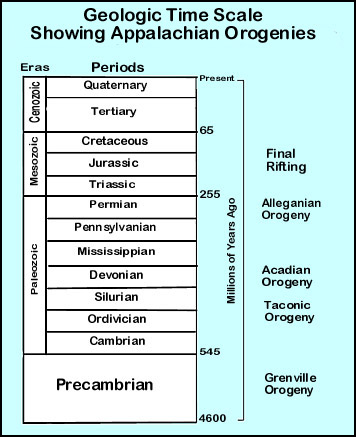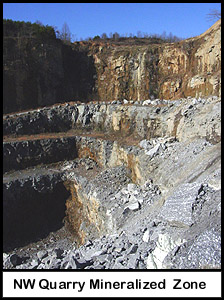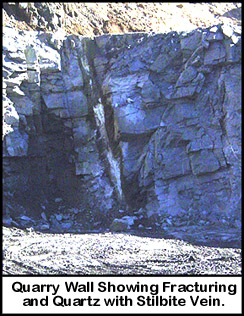
Since the Walker Top intrusion took place during the Acadian orogeny (410-330 ma) and before the Alleganian orogeny (325-280 Ma), the rock was subjected to regional compression, thus causing some metamorphic fabric including foliation. Portions of the Walker Top resemble the Henderson Gneiss (~490 Ma) in appearance and bulk chemistry. However, the different crystallization ages distinguish the two and the geologists who identified the Walker Top have suggested that its foliation looks more like an igneous flow pattern than deformational foliation (Giorgis, Mapes & Bream, 2002).
Prominent fractures cut the quarry walls and mineralized slickensides have been identified on some of them and loose boulders. Breccia and gouge evidence brittle faulting. Faulting, fracturing and mineralization may have occurred during multiple events associated with the Alleganian orogeny and Mesozoic regional
 extension (Garihan, Preddy & Ranson, 1993). Fracture-filling quartz, calcite and stilbite are thought to be the result of precipitation by
hydrothermal events during Paleozoic and Mesozoic tectonic events. A wide variety of secondary minerals, including many zeolites, are present in the
faults, fractures and voids.
extension (Garihan, Preddy & Ranson, 1993). Fracture-filling quartz, calcite and stilbite are thought to be the result of precipitation by
hydrothermal events during Paleozoic and Mesozoic tectonic events. A wide variety of secondary minerals, including many zeolites, are present in the
faults, fractures and voids.
 Secondary minerals identified by rock and mineral collectors include chalcopyrite, pyrite, rutile, fluorite, quartz, ankerite, calcite, fluorapatite, siderite,
babingtonite, epidote, laumontite, prehnite, allanite, chabazite, & stilbite. Although the sources of these minerals have not been specifically identified, certain minerals from pre-existing sedimentary rocks may have been brought into solution and recrystallized during hydrothermal events. Metamorphism may have also played a role as zeolites and prehnite can form under relatively low pressure and temperature metamorphic conditions.
Secondary minerals identified by rock and mineral collectors include chalcopyrite, pyrite, rutile, fluorite, quartz, ankerite, calcite, fluorapatite, siderite,
babingtonite, epidote, laumontite, prehnite, allanite, chabazite, & stilbite. Although the sources of these minerals have not been specifically identified, certain minerals from pre-existing sedimentary rocks may have been brought into solution and recrystallized during hydrothermal events. Metamorphism may have also played a role as zeolites and prehnite can form under relatively low pressure and temperature metamorphic conditions.
A small sampling of collectable minerals is pictured on the following page.

